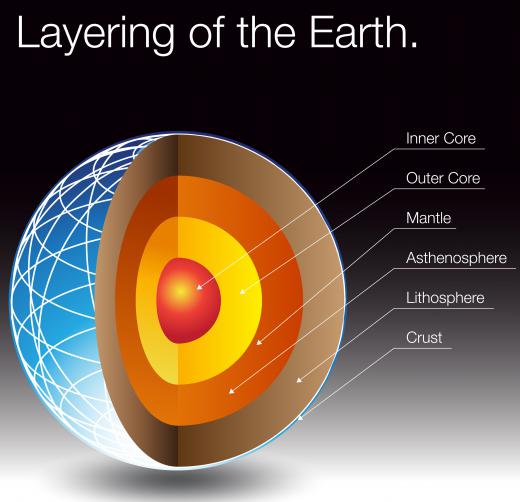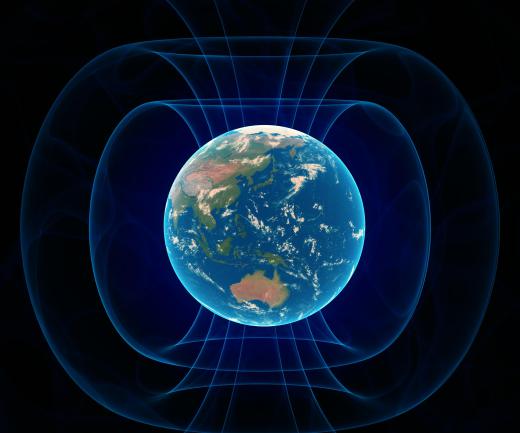What are Some Characteristics of the Earth's Core?
 Michael Anissimov
Michael Anissimov
The Earth has a core composed of two parts: the inner and the outer portion. The outer core is primarily liquid iron, and some nickel, while the inner is primarily solid iron. For a while, it was thought that the inner portion was a single iron crystal, though more recent theories predict it is more likely made of dissimilar parts, with irregular features. What scientists know about the core has been derived from analysis of seismic waves as well as models based on accepted physics and chemistry.
The outer core begins at a depth of 1,790 to 3,160 miles (2,890 to 5,150 kilometers), and there is a degree of uncertainty about the precise depth. The inner section begins at a depth of 3,160 to 3,954 miles (5,150 to 6,360 kilometers). Above the outer section is the mantle, the largest portion of the Earth’s subterranean regions. In comparison to the deeper layers, the mantle is highly viscous and continuously circulates.

It is the outer section that is responsible for the Earth’s magnetic field. It freely circulates due to stirring caused by the Earth’s rotation, with its dynamics dictated by the Coriolis effect. The effect is similar to the circulation observed in pieces of pasta boiling in a pot. This constant circulation gives rise to the Earth’s magnetic field, in a process referred to as the dynamo theory. Although the inner core is too hot to maintain a permanent magnetic field, it probably helps stabilize the field generated by the outer portion.

The Earth has not always had a solid inner core. Although the pressure there is extremely high, at one point it was so hot that the entire thing was liquid. It has cooled slowly over time and is thought to be between 2 and 4 billion years old, younger than the Earth itself, which is about 4.5 billion years old. The inner section was discovered in 1936 by Inge Lehmann.
Because the inner core is a solid suspended in a liquid, it can rotate independently of the Earth itself. Most geophysicists believe that it rotates about a third of an additional degree over the surface every year. So for every 1,000 or so rotations by the Earth’s surface, the inner portion rotates 1,001 times.
AS FEATURED ON:
AS FEATURED ON:












Discussion Comments
@MikeMason-- I don't know the exact temperature of the earth's core, I don't think anyone does but it's very hot for sure.
Some scientists say that it has been cooling down slightly, others argue against this. There is no single answer as of yet.
However, the reason for the high temperatures is because of the radioactive reactions that take place between the materials that compose the earth's core. It might also be due to the massive energy that was created while the earth was forming. But the radioactive reactions seem more plausible to me.
Good question by the way!
I've read that the earth's core is as hot as the sun's surface and has not cooled down over billions of years. Is this true? How does it stay so hot?
@anon24206-- The earth's layers are like the layers of an onion. There is an inner core at the very center, followed by an outer core, then the lower and upper mantles and finally the crust. The lower mantle is also called mesosphere and the upper mantle is called asthenosphere. The crust is also called lithosphere.
The core is solid (inner core) and liquid (outer core). The mantle is flexible rock and so is the crust. But the density and type of rock varies from place to place like the article said.
@FB-1700398611- Here is an interesting fact about the inner core. The inner core is so dense and heavy because it is likely filled composed of earth's heaviest metals. When the earth initially formed over 4.5 billion years ago, it was just a molten ball of minerals and metals. Heavy metal elements sank to the center of the earth where it formed the earth's core. This is why the core has a higher density than the other layers of the Earth. According to many estimates, the earth's core contains most of the earth's iron, platinum, gold, nickel, and uranium.
give me more details about the inner core.
OK can you give more characteristics about all of earths layers because i really like this site and i would like it even more with that stuff included
Post your comments